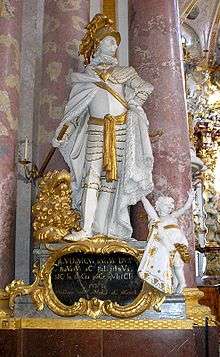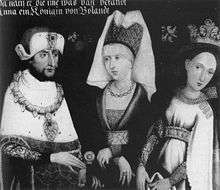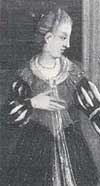Louis II, Duke of Bavaria
| Louis II, Duke of Bavaria | |
|---|---|
 Duke Louis II, as depicted in a sculpture inside Fürstenfeld Abbey | |
| Spouse(s) |
Maria of Brabant Anna of Glogau Matilda of Habsburg |
| Noble family | House of Wittelsbach |
| Father | Otto II Wittelsbach, Duke of Bavaria |
| Mother | Agnes of the Palatinate |
| Born |
13 April 1229 Heidelberg |
| Died |
2 February 1294 (aged 64) Heidelberg |
Ludwig I of Upper Bavaria (German: Ludwig II der Strenge, Herzog von Bayern, Pfalzgraf bei Rhein) (13 April 1229 – 2 February 1294) was Duke of Upper Bavaria and Count Palatine of the Rhine from 1253. He is known as Ludwig II as Duke of Bavaria. Born in Heidelberg, he was a son of duke Otto II and Agnes of the Palatinate. She was a daughter of the Welf Henry V, Count Palatine of the Rhine, her grandfathers were Henry XII the Lion and Conrad of Hohenstaufen.
Biography
The young Louis supported in 1246 his brother-in-law King Conrad IV of Germany against the usurpation of Heinrich Raspe. In 1251 Louis was at war again against the bishop of Regensburg.
Louis succeeded his father Otto as Duke of Bavaria in 1253. When the Wittelsbach country was divided in 1255 among Otto's sons, Louis received the Palatinate and Upper Bavaria, while his brother duke Henry XIII of Bavaria received Lower Bavaria. This partition was against the law and therefore caused the anger of the bishops in Bavaria who allied themselves with king Ottokar II of Bohemia in 1257. In August 1257 Ottokar invaded Bavaria, but Louis and Henry managed to repulse the attack. It was one of the rare concerted and harmonious actions of the two brothers, who often argued.
Louis resided in Munich and Heidelberg Castle. As one of the Prince-electors of the empire he was strongly involved in the royal elections for forty years. During the German interregnum after King William's death in 1256 Louis supported King Richard of Cornwall. Together with his brother, Louis also aided his young Hohenstaufen nephew Conradin in his duchy of Swabia, but it was not possible to enforce Conradin's election as German king. As a result of his support for the Hohenstaufen, Louis was banned by the pope in 1266. In 1267 when his nephew crossed the Alps with an army, Louis accompanied Conradin only to Verona. After the young prince's execution in Naples in 1268, Louis inherited some of Conradin's possessions in Swabia and supported the election of the Habsburg Rudolph I against Ottokar II in 1273. On 26 August 1278 the armies of Rudolph and Louis met Ottokar's forces on the banks of the River March in the Battle of Dürnkrut and Jedenspeigen where Ottokar was defeated and killed. In 1289 the electoral dignity of Bavaria passed to Bohemia again, but Louis remained an elector as Count Palatine of the Rhine. After Rudolph's death in 1291 Louis could not enforce the election of his Habsburg brother-in-law Albert I against Adolf of Nassau.
Louis died at Heidelberg. His eldest surviving son Rudolf succeeded him, with Adolf of Nassau becoming his father-in-law a few months later. Louis was buried in the crypt of Fürstenfeld Abbey.
Family and children

Louis II was married three times.
The execution of Maria of Brabant
He had his first wife Maria of Brabant—a daughter of Henry II, Duke of Brabant and Marie of Hohenstaufen—beheaded in 1256, on suspicion of adultery. Any actual guilt on her part could never be validated. As expiation Louis founded the Cistercian friary Fürstenfeld Abbey (Fürstenfeldbruck) near Munich.
Different sources tell varying tales about how this happened: In 1256 Louis had been away from home for an extended time, due to his responsibilities as a sovereign in the area of the Rhine. His wife wrote two letters, one to her husband, and another to the earl of Kyburg at Hunsrück, a vassal of Louis. Details about the actual content of the second letter vary, but according to the chroniclers the messenger who carried the letter to Ludwig had been given the wrong one, and Louis came to the conclusion that his wife had a secret love affair.
Over time a great many tales of folklore sprang up around Louis' deed, most of them written long after his death: Ballad-mongers embellished the tale into a murderous frenzy, during which Louis allegedly not only killed his wife after having ridden home for five days and nights, but also stabbed the messenger who brought him the wrong letter, then upon entering his castle stabbed his own castellan and a court lady and threw his wife's maid from the battlements, before he massacred his wife either by stabbing her or cutting off her head.
Several more restrained chronicles support the account of Marie's execution on 18 January 1256 at Mangoldstein Castle in Donauwörth by ducal decree for alleged adultery, but nothing beyond that.
Later marriages

In 1260 Louis married his second wife Anna of Glogau. They had the following children:
- Maria (b. 1261), a nun in Marienberg abbey at Boppard.
- Agnes (1262 – 21 October 1269).
- Ludwig (13 September 1267 – 23 November 1290, killed at a tournament at Nuremberg).
He married his third wife Matilda of Habsburg, one of king Rudolph's daughters, on 24 October 1273.[1] Their children were:
- Rudolf I (4 October 1274, Basle – 12 August 1319).
- Mechthild (1275 – 28 March 1319, Lüneburg), married 1288 to Duke Otto II of Brunswick-Lüneburg.
- Agnes (ca. 1276/78 – 22 July 1345), married firstly in 1290 Landgrave Henry "the Younger" of Hesse and secondly 1298/1303 Henry I "Lackland", Margrave of Brandenburg.
- Anna (b. 1280), a nun in Ulm.
- Ludwig IV (1 April 1282, Munich – 11 October 1347, Puch -now a district of Fürstenfeldbruck-).
Louis II was succeeded by his oldest son Rudolf.
Ancestry
| Ancestors of Louis II, Duke of Bavaria | ||||||||||||||||||||||||||||||||||||||||||||||||||||||||||||||||||||||||||||||||||||||||||||||||||||||||||||||||||||||||||||||||||||||||||||||||||||||||||||||||||||||||||||||||||||||||||||||||||||||||||||||||||||||||||||||||||||||||||||||||||||||||||||||||||||||||||||||||||||||||||||||||||||||||||||||||||||||||||||||||||||||||||||||||||||||||||||||||||||||||||||||||||||||||||||||||||||||||||||||||||||||||||||||||||||||||||||||||||||||||||||||||||||||||||||||||||||||||||||||||||||||||||||||||||||||||||||||||||
|---|---|---|---|---|---|---|---|---|---|---|---|---|---|---|---|---|---|---|---|---|---|---|---|---|---|---|---|---|---|---|---|---|---|---|---|---|---|---|---|---|---|---|---|---|---|---|---|---|---|---|---|---|---|---|---|---|---|---|---|---|---|---|---|---|---|---|---|---|---|---|---|---|---|---|---|---|---|---|---|---|---|---|---|---|---|---|---|---|---|---|---|---|---|---|---|---|---|---|---|---|---|---|---|---|---|---|---|---|---|---|---|---|---|---|---|---|---|---|---|---|---|---|---|---|---|---|---|---|---|---|---|---|---|---|---|---|---|---|---|---|---|---|---|---|---|---|---|---|---|---|---|---|---|---|---|---|---|---|---|---|---|---|---|---|---|---|---|---|---|---|---|---|---|---|---|---|---|---|---|---|---|---|---|---|---|---|---|---|---|---|---|---|---|---|---|---|---|---|---|---|---|---|---|---|---|---|---|---|---|---|---|---|---|---|---|---|---|---|---|---|---|---|---|---|---|---|---|---|---|---|---|---|---|---|---|---|---|---|---|---|---|---|---|---|---|---|---|---|---|---|---|---|---|---|---|---|---|---|---|---|---|---|---|---|---|---|---|---|---|---|---|---|---|---|---|---|---|---|---|---|---|---|---|---|---|---|---|---|---|---|---|---|---|---|---|---|---|---|---|---|---|---|---|---|---|---|---|---|---|---|---|---|---|---|---|---|---|---|---|---|---|---|---|---|---|---|---|---|---|---|---|---|---|---|---|---|---|---|---|---|---|---|---|---|---|---|---|---|---|---|---|---|---|---|---|---|---|---|---|---|---|---|---|---|---|---|---|---|---|---|---|---|---|---|---|---|---|---|---|---|---|---|---|---|---|---|---|---|---|---|---|---|---|---|---|---|---|---|---|---|---|---|---|---|---|---|---|---|---|---|---|---|---|---|---|---|---|---|---|---|---|---|---|---|---|---|---|---|---|---|---|---|---|---|---|---|---|---|---|---|---|---|---|---|---|---|---|---|---|---|---|---|---|---|---|---|---|---|---|---|---|---|---|---|---|---|---|---|---|---|---|---|---|---|---|---|---|---|---|---|---|---|---|---|---|---|---|---|---|---|---|---|---|---|---|---|---|---|---|---|---|---|---|---|---|---|---|---|---|---|---|---|---|---|
| ||||||||||||||||||||||||||||||||||||||||||||||||||||||||||||||||||||||||||||||||||||||||||||||||||||||||||||||||||||||||||||||||||||||||||||||||||||||||||||||||||||||||||||||||||||||||||||||||||||||||||||||||||||||||||||||||||||||||||||||||||||||||||||||||||||||||||||||||||||||||||||||||||||||||||||||||||||||||||||||||||||||||||||||||||||||||||||||||||||||||||||||||||||||||||||||||||||||||||||||||||||||||||||||||||||||||||||||||||||||||||||||||||||||||||||||||||||||||||||||||||||||||||||||||||||||||||||||||||
References
- ↑ Theresa Earenfight, Queenship in Medieval Europe, (Palgrave Macmillan, 2013), 173.
External links
| Wikimedia Commons has media related to Louis II, Duke of Bavaria. |
- German wiki entry for Ludwig II. (Ludwig der Strenge)
- Genealogy of Ludwig II. (compilation of various sources, in German)
| Louis II, Duke of Bavaria Born: 1229 Died: 1294 | ||
| German royalty | ||
|---|---|---|
| Regnal titles | ||
| Preceded by Otto II |
Duke of Upper Bavaria Count Palatine of the Rhine 1253–1294 |
Succeeded by Rudolf I and with Ludwig IV |